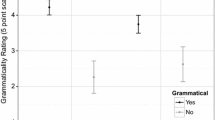Abstract
Young, severely maladaptive autistic children with some speech competence were compared to normally developing 3-year-old children of lower and middle class and 5-year-olds of lower class on negation tasks. All subjects were shown 12 sets of cards depicting negative contrasts designed to elicit semantic categories of nonexistence, denial, and rejection and were tested for production, imitation, and comprehension. Syntactic and semantic analysis revealed that autistic children were superior imitators and poor producers but showed skills in comprehension comparable to a 4-year-old's level of functioning. While retarded in some functions, the experimental group produced syntactic structures that were more rigid, suggesting the significantly greater use of imitation as a major strategy in linguistic coding.
Similar content being viewed by others
References
Bartak, L., and Rutter, M. (1974). The use of personal pronouns by autistic children.J. Autism Child. Schiz. 4:217–222.
Bender, L. (1947). Childhood schizophrenia, clinical study of one hundred schizophrenic children.Am. J. Orthopsychiat.17:40–56.
Bender, L. (1964). A twenty-five-year view of therpeutic results. In Hoch, P. H., and Zubin, J. (eds.),The Evaluation of Psychiatric Treatment. Grune and Stratton, New York, pp. 129–142.
Bloom, L. (1970).Language Development; Form and Function in Emerging Grammars, Research Monograph No. 59, MIT Press, Cambridge, Mass.
Bloom, L. (1974). Imitation in language development: If, when, and why.Cogn. Psychol. 6:380–420.
Creak, M. (1964). Schizophrenic syndrome in childhood: further progress report of a working party.Dev. Med. Child Neurol. 6:530–535.
Eisenberg, L. (1956). The autistic child in adolescence.Am. J. Psychiat. 112:607–613.
Fish, B. (1960). Involvement of the central nervous system in infants with schizophrenia.AMA Arch. Neurol. 2:115–121.
Fish, B. (1961). The study of motor development in infancy and its relationship to psychological functioning.Am. J. Psychiat. 117:1113–1118.
Fraser, C., Bellugi, U., and Brown, R. (1963). Control of grammar in imitation, comprehension and production.J. Verb. Learn. Verb. Behav. 2:121–135.
Kanner, L. (1943). Autistic disturbances of affective contact.Nerv. Child. 2:217–250.
Klima, E. S. (1964). Negation in English. In Fodor, J. A., and Katz, J. J. (eds.),The Structure of Language, Prentice-Hall, Englewood Cliffs, N.J., pp. 246–323.
Klima, E. S., and Bellugi, U. (1966). Syntactic regularities in the speech of children. In Lyons, J. L., and Wales, R. J. (eds.),Psycholinguistic Papers, Edinburgh University Aldine Press, Edinburgh, pp. 163–208.
Lovell, K., and Dixon, E. M. (1967). The growth of the control of grammar in imitation, comprehension and production.J. Child Psychol. Psychiat. 8:31–39.
McNeill, D., and McNeill, N. B. (1967). A question in semantic development: What does a child mean when he says “no”? Paper presented to the Society for Research in Child Development.
Piaget, J. (1954).The Construction of Reality in the Child, Ballantine Books, New York.
Rutter, M., and Bartak, L. (1971). Causes of infantile autism: Some considerations from recent research.J. Autism Child. Schiz. 1:20–32.
Shapiro, T., and Fish, B. (1969). A method to study language deviation as an aspect of ego organization in young schizophrenic children.J. Am. Acad. Child Psychiat. 8:36–56.
Shapiro, T., Roberts, A., and Fish, B. (1970). Imitation and echoing in young schizophrenic children.J. Am. Acad. Child Psychiat. 9:548–567.
Shapiro, T., Fish, B., and Ginsberg, G. (1972). The speech of a schizophrenic child from two to six.Am. J. Psychiat. 128(11):1408–1414.
Shapiro, T., Chiarandini, I., Fish, B. (1974). Thirty severely disturbed children.Arch. Gen. Psychiat. 30:819–825.
Siegel, S. (1956).Nonparametric Statistics for the Behavioral Sciences, McGraw-Hill, New York.
Winer, B. J. (1971).Statistical Principles in Experimental Design, 2nd ed., McGraw-Hill, New York.
Author information
Authors and Affiliations
Additional information
This work was done at the NYU-Bellevue Medical Center with partial support by NIMH Grant No. MH 07331 to R. K.
Rights and permissions
About this article
Cite this article
Shapiro, T., Kapit, R. Linguistic negation in autistic and normal children. J Psycholinguist Res 7, 337–351 (1978). https://doi.org/10.1007/BF01080221
Received:
Issue Date:
DOI: https://doi.org/10.1007/BF01080221




